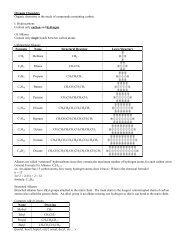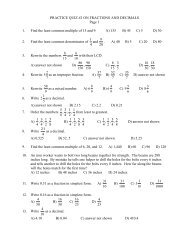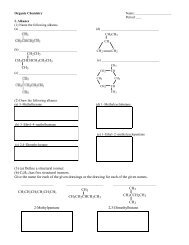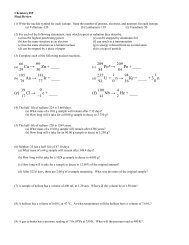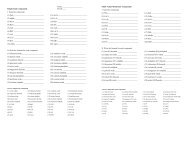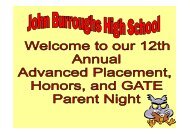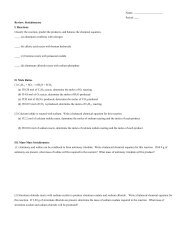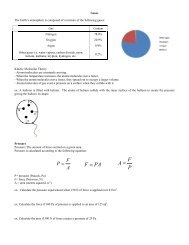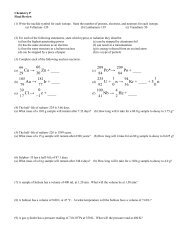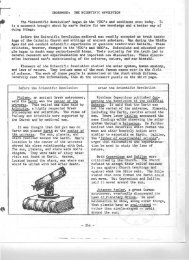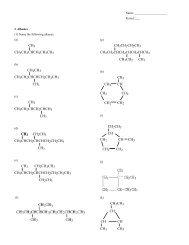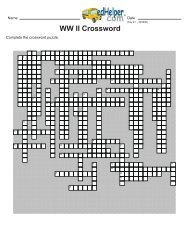World War II (1941 – 1945)*The Course of the War*- We won. Hah.(Don’t worry: military history is NOT on the <strong>AP</strong>! I just summarized it a little more concisely this time, anyway!)*The Wartime (and Post-War) Conferences*- Now THIS is important. The key conferences are as follows: Teheran Conference (December 1943) – FDR, Stalin & Churchill met. The main issues were: The opening of a second front (the fact that they hadn’t already was annoying Stalin),which led to a decision to invade France in 1944. The USSR also promised to help against Japan as soon as Germany lost. Dumbarton Oaks Conference – The US, GB, the USSR, and China basically talked over thedetails of the UN here, finally deciding on the Security Council/General Assembly we all knowand love today. Yalta Conference (February 1945) – FDR, Stalin & Churchill once again. They discussed… Poland: After letting the Germans wipe out an uprising, the USSR had installed itsown gov’t – but another one was still waiting in London. So it was decided that theUSSR would get more territory but would (supposedly) use a coalition gov’t there. Germany: They decided upon its division into four zones, and a preliminary figure forreparations (most of which would go to the USSR). Stalin also promised (again) to declare war on Japan soon after Hitler lost and sign atreaty with Chiang in China (not Mao). In exchange, the USSR would get back someof the land it lost in the Russo-Japanese war. Yalta was the high water mark of diplomatic relations between the three and then… Potsdam Conference (July 1945) – Truman replaced FDR here. They discussed…. Germany: They agreed on disarmament, dismantling of war industries, denazification,and war crimes trials. Japan: Unconditional surrender. Not much else was actually settled, as the spirit of unity had been broken and therewas much haggling about gaining/losing territory & spheres of influence and so on…- That’s all.*World War II: The <strong>Home</strong> Front*- In many ways, what occurred on the home front in WWII is very similar to what occurred during WWI,although there were also some significant differences. Here’s what you should remember about the homefront in WWII: Propaganda – FDR started out by getting everybody geared up with his Four Freedoms idea(speech, worship, want, fear), and telling people they had to go out and fight for the <strong>Am</strong>ericanWay of Life. To help get the idea around, he established the Office of War Information (1942)to take charge of the matter – Hollywood joined in too, of course (Capra’s Why We Fight). Gov’t Regulation of the Economy – As follows… Office of Price Administration (1942): The OPA quickly went to work controllinginflation through price ceilings on <strong>com</strong>modities and rents, as well as establishingrationing through local War Price & Rationing Boards. Many businesses protested,and blamed the OPA for scarcity, but tough luck for them. War Production Board (1942): Following Pearl Harbor, the WPB was established toconvert the economy from civilian to military production.War Manpower Commission (1942): Recruited workers for the factories.Gov’t Incentives in Business: The gov’t guaranteed profits (cost-plus-fixed-feecontracts), lowered taxes, and excluded businesses from antitrust laws. Witness therise of the dreaded military-industrial <strong>com</strong>plex.Results of the Wartime Economy – As always, unemployment basically vanished, and peoplestarted making more than ever. The gov’t didn’t even bother to overtax them, instead relyingon deficit financing. Also, industry (and especially agriculture) experienced yet another periodof consolidation.Federal Support of Science & Technology – Like business, scientific enterprises all got biggeras the gov’t poured $ into big universities and military/science projects.68
Growth of Organized Labor – A labor/management conference agreed (after PH) to a nostrike/lockout pledge to guarantee war production. The NWLB was then created to overseeany disputes – unions were allowed, but workers couldn’t be forced into them either. It wasn’tall good, though, b/c when the NWLB tried to limit wage increases in 1943, workers struck bigtime, leading to the War Labor (Smith-Connally) Act (1943), which gave the presidentauthority to seize and operate plants w/strikes if needed for nat’l security, and gave the NWLBthe authority to settle disputes for the duration of the war. Growth of the Federal Gov’t – The gov’t increased both its size and power during the war, esp.the executive branch, which now also had to manage the labor supply and control inflation. Japanese Internment – Also as a result of the war, thousands of Japanese citizens were“relocated” to internment camps. Opportunities for African <strong>Am</strong>ericans – Although blacks were able to find jobs in the military andin cities (Executive Order No. 8802 outlawed discrimination in defense industries), they stillfaced major problems and race riots in the cities (1943). Membership in civil rightsorganizations increased as a result. Opportunities for Women – In addition to being more involved in the actual army/navy action,women took new war production jobs.- So there you have it. No more outlining of the book for me tonight, sorry. This will have to be a short one.Postwar <strong>Am</strong>erica (1945 – 1961)*Truman’s First Term: Domestic Policies*- Truman had be<strong>com</strong>e President after FDR’s death, and was subsequently the one who had to face thepossible economic consequences of demobilization – as war contracts were cancelled and price controlsremoved, cutbacks in production led to layoffs and inflation.- Truman responded by decided to <strong>com</strong>bat unemployment through expansion on the New Deal programslike unemployment <strong>com</strong>pensation, minimum wage, farm supports, public works, and so on. He also broughtback the idea of FDR’s Economic Bill of Rights (everyone deserves a job).- It turned out, though, that while there was temporary high unemployment the economy remained stableand even boomed! Why? People had saved up during the war, and easy credit promoted buying. The onlybig problem was inflation, spurred by shortages of goods and housing.- However, inflation soon led to a decline in real in<strong>com</strong>e (purchasing power), so workers becamediscontented b/c they felt they weren’t sharing in the widespread prosperity. In 1946, unions responded byordering nationwide shutdowns and strikes.- This further limited production and created more inflation, so many people began to get very pissed at theunions, including Truman, who declared to Congress that if an industry vital to nat’l security refused to returnto work, all the workers would be drafted into the army. This really angered labor, though!- Another debacle occurred w/Truman’s handling of the OPA (price controls), which big business &consumers wanted lifted. When they did expire, however, inflation rose further. People blamed Truman,leading to the Republican majority in both houses in the 1946 elections.- Taft-Hartley Act (1947) Prohibited the closed shop (union only), permitted states to ban union-shopagreements, forbade union contributions to candidates in federal elections, forced union leaders to swear inaffidavits that they were not <strong>com</strong>munists, and mandated an 80 day cooling off period before carrying outstrikes. This enraged labor, but helped Truman, who was vindicated in their eyes through his veto.- The Republican Congress also offended other groups, like farm organization, with their obliviousness topublic demands. Still, though, it seemed like they had a sure Presidential victory.*Truman’s Second Term: Domestic Policies*- Anyway, in the Presidential Election of 1948, in addition to the Republican candidate, Thomas Dewey(G-NY), Truman faced two other parties: (1) the Progressive Party, which advocated friendly relationshipsw/the USSR, racial desegregation, and the nationalization of basic industries and ran Henry Wallace, aNew Dealer who had been fired by Truman for criticizing US foreign policy and (2) the Dixiecrats, who ranStrom Thurmond of SC and consisted of anti-civil rights Southerners.- So, basically, most people felt that Truman was totally screwed. As a last ditch tactic, he called the allRepublican Congress into a special session and challenged it to enact all their plans. They did nothing in theend, giving Truman the opportunity to go around the country taking about the “do-nothing” Congress.- And Truman won! Why? Well, the US was doing well economically, at peace, and united on foreign policy.Plus, the ND coalition – blacks, union members, urban ethnics, and most of the South – still remained, andfarmers joined as they worried the Republicans would lower price supports.69
- Page 3 and 4:
Congregationalists (Puritans) - The
- Page 5 and 6:
- So the Restoration Colonies, form
- Page 7 and 8:
- So in England, where they were lo
- Page 9 and 10:
*Colonial Politics 1700-1750: Relat
- Page 11 and 12:
- Another ideology that was beginni
- Page 13 and 14:
- The Quebec Acts were passed aroun
- Page 15 and 16:
- So, by 1782, what had seemed to b
- Page 17 and 18: on the economic side, since the gov
- Page 19 and 20: - Anyway, Congress had several ques
- Page 21 and 22: - Adams was still in the early Wash
- Page 23 and 24: *Political Factionalism and Jeffers
- Page 25 and 26: - Samuel Slater set up the first te
- Page 27 and 28: - Court rulings extended the powers
- Page 29 and 30: Revival, Reform and Politics during
- Page 31 and 32: - Anyhow, during his administration
- Page 33 and 34: TEXAS (Southerners) - Texas had bee
- Page 35 and 36: - Anyhow, Pierce’s total support
- Page 37 and 38: They had a smaller everything: smal
- Page 39 and 40: - The two Northern victories at the
- Page 41 and 42: - The result was the Fourteenth Ame
- Page 43 and 44: The Slaughter-House Cases (1873) -
- Page 45 and 46: in the arrest of 8 immigrant radica
- Page 47 and 48: case (1897 - ICC can’t set rates)
- Page 49 and 50: - The Populists prepared to run aga
- Page 51 and 52: - MOST IMPORTANTLY, though, was the
- Page 53 and 54: - So, what led the US to undertake
- Page 55 and 56: - The rebellion, led by Emilio Agui
- Page 57 and 58: - Still, Americans managed to turn
- Page 59 and 60: - So - the point of this episode? B
- Page 62 and 63: *Hoover’s Response*- Poor Herbert
- Page 64 and 65: - In FDR’s second term, however,
- Page 66 and 67: Dominican Republic - When we left i
- Page 70 and 71: - So Truman started off again all c
- Page 72 and 73: - First of all, the 1950s were (for
- Page 74 and 75: peace w/Japan that ended occupation
- Page 76: - France wanted out, so at the Gene



